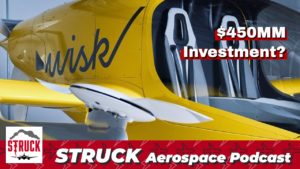Will the 4-seat Voloconnect EVTOL change everything for Volocopter, as they moving into longer range flight prototypes? Beta Technologies got a big investment round from Fidelity and Amazon-what does this mean for the company’s future? Plus, Allen talks electrical grounding; is Boeing in trouble with their latest 737 electrical problems?
Learn more about Weather Guard StrikeTape segmented lightning diverter strips. Follow the show on YouTube, Twitter, Linkedin and visit us on the web. Have a question we can answer on the show? Email us!
Podcast: Play in new window | Download
Transcript: EP54 – Voloconnect EVTOL, Beta Technologies Investment, Plus Boeing Grounding Issues
0:00
This episode is brought to you by Weather Guard Lightning Tech at Weather Guard. We support design engineers and make lightning protection easy.
0:14
You’re listening to the struck podcast. I’m Dan Blewett. I’m Allen Hall. And here on struck we talk about everything aviation, aerospace engineering and lightning protection.
0:33
Alright, welcome back to the struck podcast. I’m your co host, Dan Blewett. On today’s show, we’re gonna catch up a little bit talk about some good growth Coronavirus News with quarantine free flights, from American to Italy. We’ll talk a little bit about Airbus and Air France, standing, potentially standing trial over 2009 crash and a potential partnership between Rolls Royce and Boeing. In our engineering segment, we’ll talk about grounding today, as it kind of relates to some of the new Boeing 737 issues which that plane remains embattled. And then lastly, bunch of E VTOL. News to catch up with some really interesting stuff from Volocopter. We’ll talk battery tech a little bit re lilliam and Beta Technologies. So Alan, how you doing, sir? Hey, great, Dan, we’re almost out of COVID in the United States. I know. The mask mandates have been lifted recently and will be lifted at the end of the month. So that’s that’s a really good sign. I hope our friends, especially our friends in Europe, and in India and South America
1:40
can get to this point relatively soon. I know there’s just a lot of a lot of Coronavirus going on around the world. And it’s really serious in certain parts. So from the aviation community standpoint, it’s a big problem.
1:54
Travel is still going to be limited for the next several months easily. Yeah, well, and so, so much reporting on American Airlines, they’re offering customers flights, quarantine free from JFK to Milan, and and from JFK to Rome. So yeah, basically, customers will have to provide proof of a negative COVID test and then also get a COVID test when they arrive. But after that, they can pretty much go about their merry way, which seems like a you know, big sort of breaking of the seal. Because international travel has been a big No, no, right? It has been it. But it’s also really done a lot of damage to the economies that rely on vacation or some business travel. It’s just been slammed, totally slammed for more than a year now. And it’s it can’t go on much longer without really having lasting lasting
2:46
consequences. And so it’s good that at least where we can do it. We should be starting to open up some of these routes. Obviously, having the COVID test makes infinite sense. Having been vaccinated, I had my second vaccination over the weekend. And that was an experience. But if we can do
3:07
it little 16 hours of sickness.
3:09
Oh, yeah, it was here. Now. It did. It really did. It really did. I felt like it felt like I was having the flu, every part of my body was achy, and tired. It was amazing how fast that reaction happened. But, hey, I wanted to go through that if I could travel again, or travel more, I’ve already traveled quite a bit. He already COVID times. But it’s it’s you know, always like super cautious about wherever you go. And rightly so me in the vaccine is not going to prevent you from catching it necessarily. But it’ll just knock the symptoms way down. And hopefully, as we get through the summertime, more of this type of travel will happen. Yeah, and interesting, as a Rena article earlier about the Yankees and how they had a little COVID outbreak recently. And it was kind of exploring that idea that well, the vaccines are pretty effective. But even when they’re not completely effective at preventing people from getting COVID because obviously, all the Yankees players were you know, vaccinated. Go, yeah, but nine, I guess nine got it. And seven were symptom free. So that seems like a pretty good result. Because I think that for a lot of us, the the day is just what everyone’s worrying about, like, would you be that one person that really has lingering effects and, and obviously a lot of people lost their lives. So that’s
4:29
it, it’s just like a normal sickness and you know, not too too bad, where it’s going to really, you know, you could lose your life or be in the hospital or exactly long term effects. That’s the big thing. So Right, right. Yeah. And that’s where it gets back to normal life. If it really was just like a bout of the common cold or just something moderate, then, you know, that’s humans have been dealing with that forever. But obviously, it was not that for so long. It was pretty scary, especially when people are still still dying as we learn more about it. Yeah, and I had traveled over the last
5:00
week or so across the country on some business travel. And I was shocked at the number of people that were traveling. It was midweek
5:10
in different different stops along the way from West Coast east coast. And it was amazing the number of people that were traveling and it’s the level of of tension you could feel it at the gate was
5:24
much, much, much less everywhere you were even in the restaurants and things are starting to open up again in the in the walkways and in the taxiways, all that stuff is open that was closed, for at least a year is starting to crack open again and which is a good sign. But I always feel he could feel the panic. Last summer when you’re traveling. It was very serious. It was really serious travelers and everybody who has might have their P’s and Q’s the whole time. In this last time it was people going on vacation clearly going on vacation. clearly going to like some people are going to Vegas have a good time. So you saw a lot more general activity. It wasn’t like a needed travel times. Things have changed the condition. The vaccines helped a lot. Alright, so moving on, we’ll get your opinion here a recent article about Airbus and Air France, they’re potentially going to be ordered to stand trial in a criminal sense over 2009 crash that 220 people lost their lives specifically related to freezing of was it pido tubes or Peto probes? Are they interchangeable? interchangeable? Pretty much today? Yeah.
6:35
And so it sounds like they had icing issues. And it sounds like there were some service bulletins or mandates to swap those out. But yet, this issue still happened in the plane, I guess. What is it the nose got a little high during the during the flight and they stalled all in crashes? Yeah. fell out of those. Yeah.
6:57
I guess the big question is why why a criminal complaint here rather than just a civil
7:04
a civil one? Well, it’s a it’s it has to be related to specific French or European law. And in the United States, I think this would never get this far. There would be settlements and
7:17
signing of documents to prevent future lawsuits. But in this particular case, I think because it was everything’s internal to France, right. So you got Airbus and you got Air France and then you have a lot of French families that the flight was coming from Brazil, to France.
7:35
And it Peto probes, most likely I Stover based on the data from the crash and all the reconstruction that had happened, airplane stalled fell about 40,000 feet into the ocean. And no one can figure out for the for a while, like what had happened. It’s just so bizarre, but incidents have happened.
7:53
The legal ramifications are odd in the sense that if you’re trying to prove negligence, it’s going to be hard to do that. Because the regulator’s I’ll allow the paedos to be changed over a period of time. You can’t unless there’s like something really, really severe happening. It’s rare that iasa FAA Transport Canada just grounds an airplane and says you got to fix us like FAA did with the 737. That those situations are very rare. Usually, there’s a timeframe if they have some sort of known issue, and it’s not catastrophic in nature, to let you make those changes over time because airplanes don’t need to be in service and all those kind of things. So there’s an out for Air France and Airbus, which is that the regulators allow them to do this. And I’m sure that what they’re going to point to now what happens in a French civil court Who the heck knows what’s going to happen there. But if you’re going to hold somebody culpable for that, then it’s good. Most likely, it’s going to be some engineer somewhere, unfortunately.
8:57
And that’s just a bad situation. Because when you start going after engineers who are doing at least theory are doing the right thing is
9:09
it miss you know, intended to kill somebody clearly. Then you’re citing intent to kill somebody or to kill a couple 100 people.
9:19
That gets hard to prove in a courtroom realistically. But if they do find somebody guilty, every engineer that’s working on Airbus, or Air France is going to be totally tight about what they’re going to sign off on forever, because
9:35
it isn’t like they’re making the decision in a vacuum. They’re making a decision with all kinds of people who knew about it. There are probably hundreds of people who knew about it from from the lowest mechanic to the highest people in the corporations knew about it.
9:49
It’s an interesting concept, because back in the day, this was from a camera which book I was reading that if you built a bridge, you’d have to sleep under that bridge for a couple of days to essentially like house
10:00
Get in the game. Yeah, I mean, and there’s and I think there’s some merit to that, you know, if you built a house and a collapse on the family that you built it for you, we’re going to be in serious trouble, like, either imprisoned or maybe even killed. I mean, obviously, there’s a long time ago, but there’s some merit to that, right? We’re not saying that you should kill it if, you know, by any stretch, but like, there is some merit to having skin in the game. And like you said, If you know, there’s serious consequences to not thinking through one of these solutions that could cause people lives, you’re going to think a lot harder about what’s going on. But like, like you said, This is such a, in today’s society, it seems like these are civil penalties, not criminal penalties for, you know, because like you said, if you’re an engineer, and you say, I have some concerns there, what else is like, Oh, no, it’s gonna be fine. We’ve all checked it, we agree. And then then it comes back to you. That seems really problematic, right? If it’s a whole team signing off, rather just one person, like if I just built you a house, myself, and it fell on your family? Yeah, like, this was this was on me, right. But if it’s a whole team, and all these big companies are really large with lots of checks and balances, then it just becomes a lot more difficult to point the finger at one person and assign criminal criminals, right. Well, I think in the, in this particular case, I think they noticed that the Peto probes didn’t have the corresponding more proper amount of heat in certain high altitude icing situations, and it’s all about how hot you can get those probes to keep ice off on and in the situation would be if if there’s always risk everywhere. If you saw that there was a situation would you raise it? Maybe, maybe not, you know, what the worst case situation is you bury it and all those airplanes were at risk instead of just the one. Moving on. Let’s talk about Rolls Royce and Boeing. So they’re potentially holding discussions to start new aircraft program. And it sounds like they want a range jet out. Alan, what is what do you what feels like mid range to us? They said somewhere between 737 in the 787? I mean, what what market does that hit? It hits a lot of US markets, South American markets, European markets, Asian markets.
12:10
It’s a lot of different areas. I, the Curiosity is like what size? Is it going to be? How many passions are we talking about? Because that’s always been that weird spot like what is between a 737. And like even a 757, like a 757 has been gone for quite a while they’re still in some are still in service. But there was that triple 7747 on the big end 767. On the big end, you got the we used to have 727 717, one that was around for that brief moment. 737. So slightly larger 737 I guess the 787 doesn’t really fold some of these rolls, like they thought it was going to an airplane kind of gets a persona after a while and it gets slotted as to where it’s useful market is because the airlines figure it out pretty fast. So if there’s a marketplace in there slightly, is it a stretch 737? Is it a re engine 737? Is it a? Is it a max plus? Like what is this thing, and nobody knows yet. But the thing about Boeing and new aircraft programs that sometimes Boeing is doing things just to jerk the chain of Airbus, or to jerk the chain of Embraer and for whatever reason, there’s a lot of sabotage corporate sabotage going on all the time. And I wonder, you know, How real is this thing? Because, I mean, you haven’t heard much coming out of Boeing for quite a while and new designs, and you wouldn’t think they have a lot of cash flow to go off and do something new. So you kind of wonder How real is that? Is this is this is another play that make Airbus flinch and do something like make it 380? Or is it something real, who knows not to just keep your ear to the ground and see how it progresses here.
14:06
Alright, so moving on in our engineering segment today, let’s talk about grounding. So Boeing has had some more issues with their 737 Max, that basically sort of uncovered a manufacturing issue where they weren’t getting full metal to metal contact, because of the way basically the manufacturing process of a hole being drilled. And it sounds like they had called initially for it to be
14:31
like a layer of coating applied and then the holes drilled. And apparently that got reversed and impacted grounding. And now 60 of the aircraft out of the 200 1000s that have returned to service are now
14:45
grounded for this issue. So Alan, let’s talk a little about grounding in general. I mean, this is obviously something that doesn’t it’s not a you know, like a sexy topic, but it’s a really important topic when it comes to airplane design. Sure, it is it’s I’ve heard
15:00
differing reports. If you look at the different news sources, they say slightly different things. And I want to say this sort of lost in translation thing between engineers and reporters. But it sounds like at least in the one article that I read recently was as a coating on some fasteners. And I mean fasteners like rivets, things that attach structure to structure or boxes to structure. And in this particular case, it sounds like they changed the coating on some fasteners in the emergency power distribution box was grounded the way that it should have been? Well, that’s a problem from a system safety standpoint, because you need that thing to go fly. In something as small as some coating, it literally is less than 1007 inch. Most of this coatings.
15:44
Something like a coating on a fastener or a coating on a piece of metal can degrade the performance of the system can lead to serious, it could lead to catastrophic results. In theory, that’s really, really serious. So if you’re in a manufacturing scenario, like Boeing is or any of the aircraft manufacturers, or Airbus has the same issue. When you’ve got 1000s of parts, hundreds of 1000s of parts, you’re talking about the finish on a couple of pieces of bracketry, or rivets being changed for for who knows what reason, bulk buys,
16:20
engineer didn’t realize trying to save time, they put it as an alternate, oh, there’s 1000 reasons why you get into the situation. But those little small changes can have bigger system impacts. And
16:35
you need to have a system in place that engineers who know how that system works electrically, mechanically, operationally need to be involved, and even some of the minor discussions and changes that happen on the manufacturing floor. So I think I got caught, most likely got caught because they’re doing body checks, and they had some come up bad. And then red flagged that and engineers start coming down on the floor and figuring out what was going on. And it’s not uncommon, because there’s so many moving pieces and so many things happening simultaneously on an airplane bill, it’s it’s an easy thing to occur. And Boeing took the took the reins on this basically away from the FAA. And a sense that they identified the issue. They identified the aircraft, they identified the repair. And they said, Well, this is what we’re doing. And the FAA just sort of said, Well, okay, that sounds good. So the FAA didn’t really have a lot of saying it, because Boeing had already developed their fix for it, which is a little bit unusual. Usually, there’s a little interplay between the FAA and like, here’s the situation, here’s what’s happening. Here’s the options we have. Here’s what we’d like to do. And there’s an agreement in this particular case, Boeing is like, we can’t afford to have any more screw ups. We’re gonna kill this problem right here right now. And FAA, are you on board? And the answer is yes. So way they go. But simple things like really simple things like coatings and paints. And those sort of things seem irrelevant, but they have a big effect on system performance. They just do. Yeah. And this article from the E times just highlights that Wall Street Journal had one reporting of what the issue was aviation, we got another like you said, another report of it. And the Seattle Times had a different report that just sort of forgot. They weren’t exactly sure, you know, which was the right one, but like you said, it’s a, it’s a huge thing. I mean, you and you do this all the time. Imagineers contact you about Radome design, and they’re asking you, it seems like a lot of nitpicky solutions, but they’re not right. They’re saying what size Steel’s this what what size, you know, strap or, you know, like, wire all those details. I mean, especially on like a rate on like a Radome. I mean, why does the size of a screw or a fastener that, you know, creates a, you know, the final electrode connection? Why does that matter so much? I mean, is it just current, especially when you’re dealing with like lightning strikes? Yeah, it’s how much energy a piece of metal can handle and the bigger it is, the more likely to be able to handle the certain amount of energy. And even coatings, will play into the lightning survivability of a particular kind of fastener. All those little details do play into it. And so you have to be very specific, we need to use this kind of fashion or with this kind of coating, and it needs to be connected to this kind of bracket with because if you don’t, it may come apart in flight. And you may start losing pieces off the radar, which never is good, especially if you suck them into an engine. So you really want to make sure that you’ve properly sized the pieces one and two, that the coatings are right and that you have the proper electrical connection. If you do all those things, right. You’ll pass lightning tests, no sweat, it’s just when you forget about a detail. And I’ve seen it happen many times we’re a company runs out of that particular fastener finish and they’re going to a test they grab another faster fish just shove it in there. It’s the same size faster. What’s the problem? Boom, you know, and lightly tested blows the thing apart? Well, things little tiny details do matter here. And that’s why a lot of
20:00
A lot of companies and engineers reach out and say, Hey, to me and say, What do I need? What specifically do I need all the way down to faster finishes? And the size of the fasteners? And even sometimes the material? Is that stainless steel crests? Or is it regular steel, CAD plated? Whatever? What what works in this situation and usually have a list, but that is a common question. And all those little details matter. They always do, they always do.
20:31
Alright, so in our E VTOL. Segment today, let’s start with Volocopter. Allen, they’ve done a lot of really cool things I have liked their designer, you’ve you’ve liked their design a little bit. Yeah, they have a brand new one called Voloconnect, which is a longer range, air taxi, potentially a four seater, very futuristic looking, I’ve always liked their I mean, they’re like, they seem to be like the apple, like a design color schemes and stuff like that of the AV GL market. But this looks like a big, big change, and obviously a different market, which, you know, I think we both expect that you’re going to continue to see different iterations, like everyone’s had the same sort of like, let’s just, you know, short range, but this one’s a significantly longer range.
21:16
You know, bigger payload vehicle. So I mean, what sticks out to you about the Voloconnect.
21:23
You know, aesthetics and aerodynamics and just the design of it in general. Well, the the need for vertical takeoff. And landing really drives a lot about the design. And if you if you go online and take a look at the the aircraft design, it has a couple of booms, essentially, that tie structure together. So there’s two long booms and there’s a bunch of motors and propellers on these booms that provide the vertical takeoff and landing aspect to it. So that from a design standpoint, I it seems functionally this will work, right, it’s very similar to the beta design. That’s, that’s happening. Now, those so those two aircraft are very similar in nature and the way they’re structured. The penalty for the vertical takeoff and landings, but seems to be huge, though, in a sense that you got these two structural, big structural pieces, which are heavy, and they’re full of extra motors that you don’t use for forward flight at all. So they’re only used in very short spurts in the beginning and ending a flight. It makes you wonder if that weight cost trade off is worth it is the vertical takeoff and landing that valuable that you want to eat that weight, cost complexity aspect, or is short takeoff and landing a better option. Because there’s a big discussion in the aviation community. Like, if I had 200 feet of runway is that enough, maybe that may be enough, and then the vertical, I don’t need the vertical. So I get rid of hundreds of pounds of weight and complexity.
22:55
I just need a 200 foot stretch of grass or asphalt to take off and on off. Maybe, maybe it’s going to be a very, very interesting fight, I think coming up because some of the aircraft designs are eating that boom weight and motor weight. And some of their aircraft designs are basically incorporating a standard aircraft configuration without the extra structural components. So what they’re doing to get the vertical takeoff is basically tilting the motors down to provide vertical thrust. So there’s not extra structure there. And you got to think that that’s a much cleaner, simpler design it to basically tilt the motors and not add the boom wait.
23:40
it to me and Dan, I know I’ve been watching a little more and paying a little more attention to what the the sale price of these aircraft are going to be. does seem to be hone honing in on the four to $5 million
23:55
aircraft price per aircraft price was seems extraordinarily high to me right now that the competition in a lot of cases is probably a Cisco 206 or beach Bonanza kind of thing.
24:13
Which are a lot less money.
24:15
It’s just a lot less money.
24:18
Yeah, what if and if you start getting to where they’re not EBT wells anymore, then you say well, what about one of these other companies like ampair that
24:27
doesn’t or buy or buy aerospace? Right? It has a basic standard electric design and buys going after the king or market on the twin market. It was where they’re headed. But that’s a really good point. Like how much vertical do you need? And maybe spots of Europe? Totally, you know, London, I think Yeah, Los Angeles, New York. Probably Houston United States, maybe Chicago. Okay. But after that, almost most of the American cities are not that
24:59
do
25:00
It’s where you’re just not dozens of runways around them, particularly in the Midwest, there’s all kinds of runway also the place you actually open a chart and look at runways all over the place.
25:09
So do you need that vertical aspect? And I,
25:12
the market is going to determine that, but you’d hate to see hundreds of millions of dollars invested in something which doesn’t produce useful aircraft or, or sustainable company at the end? That’s, that’s the worry.
25:28
Yeah, because I mean, the VTOL aspect of it, that vertical takeoff and landing, that seems to be the big thing that no other like ampair can’t do. But they can do a lot of other things. Well, just like with Tesla, they’re going to be suddenly competing with a lot of, of similar electric cars, or what’s what’s Tesla’s standout feature after that? Or is it just the fact that they’re first to market and they have some, you know, the, the premium veneer and brand awareness and brand user interface value? Yeah. So then if they’re going to be closer to, you know, someone’s gonna say, Well, why spend 75 grand on a Tesla, when I could spend 45 on a pretty nice looking Volkswagen platform or Chevy, right, they’re just going to get to that point. Whereas if you lose the VTOL thing here, now you’re competing with all the other like you said, like, by airspace and all these other ones. And now it’s a different ballgame where $5 million doesn’t work for anybody. But you know, yeah, yeah. So as a nice jet. Yeah. Hmm. So that was?
26:31
It is it’s a very fascinating problem, because
26:35
in any other marketplace, I don’t think this gets the funding that this is received right now. In the automotive world, I don’t think you’d see it, I don’t think you’d see it in many other types of sort of consumer product industries, I don’t think you would see the investment. I think COVID has held, there’s been a lot of money sidelined, and there’s been a lot of money that’s just been waiting to invest in something cool. And so here you go. A lot of the companies are based in Silicon Valley, because there’s a lot of cash hanging around there. And not a Wichita, which doesn’t seem to have or Dallas or wherever it doesn’t seem to have those kinds of investors sitting around willing to do that. So you got this really unique timeframe space.
27:18
But the connection to the consumer market hasn’t quite jelled yet. So we have a little more fall out here. Still, I think another couple of months of trying to figure this out. Once speaking of investment, fidelity and Amazon have backed
27:33
Beta Technologies, which they have a really other guy, I think their designs pretty cool. It’s pretty interesting. It kind of looks like a helicopter with a big wing. And I don’t know, what’s the what’s the technical? For those two?
27:47
things on the top? I’m just calling them booms. Yeah. Okay, booms. Oh, I guess it propulsion booms of some sort, because that’s what they’re there for. They’re only there to provide platform structural platforms for the motors. That’s it.
28:01
But beta is now a unicorn. So they’re valued at 1.4 billion with this new funding round. That makes Amazon
28:08
Amazon? Well, if you have a lot of money in the bank account, you’re valued at at least that money. So they’ve got you are the cat Oh, yeah. But they always had that weird multiple to it, like I get it’s worth whatever the money you have in the bank is, but then where’s the multiple come from? And what’s the track record on the bank that multiple cars is the next round of investment? on that on that multiple? Ooh, now? It’s a good question. Well, yeah, well, I you know, the thing about beta, which is, well, I think all of them are all of these aircraft companies are a non standard aviation manufacturing centers, is that you got to build a lot of infrastructure. And so some of that 300 $400 million is going to go into buildings and infrastructure and tooling, and blah, blah, blah, all that boring stuff, that costs a lot of money, you’re going to be pouring some part of that in there. And I don’t know, if 350 $400 million is going to do it.
29:00
It doesn’t feel like it. And a lot of aircraft programs have been a half a billion to a billion. And it seems like they’re a little short yet. Now, they may be taking a more cautious approach at beta, which does seem to be the case, by the way. They seem to have a well thought out plan. The question is, how fast is that cash burn? And can you get through certification without that level of funding? I don’t think so it’s going to be close.
29:26
So it’s gonna, it’s gonna be really interesting to watch because there’s so much need for so much cash. Your investors are going to be really limited, I think, unless you start looking like a lot of companies looking overseas. And there’s been a lot of Chinese investment, specifically Chinese investment in American aviation companies for a number of years. That’s where they go when they sort of run out of caches or they’re desperate for cash. They turn up with Chinese owners. We’ll see. Well, and with beta, they’ve had, you know, we were poor.
30:00
On this a couple weeks ago that they had the big order with ups, and they had they have a good order with
30:08
United therapeutics to carry organs for transplant and US Air Force, agility prime program. So they’re one of the few who have a lot of potential, you know, buyers share plans, they have these orders. So yeah, it’s a big piece of it. Did you read the the, the story that came out of Vermont, talking about the different investors they have, and there’s a lot that the investors can do to drag in potential customers. It’s sort of a who, you know, network that’s unlimited. It’s like, on the yacht, and of boating, it’s sort of who, you know, you have to be in that circle of people who have the cash to fund these things. And I think they’re doing a good job of connecting dots between investors and operators, that they seem to be doing the right sort of social interactions, meet and greets, that must be part of their plan. And that seems to be paying off for him because they have they fully invested in that in that first real seed of funding.
31:13
But boy, you know, you still got a long way to go. Yeah, well, and, you know, it’s funny how, just like in a Kentucky Derby, you know, until you’re really down the homestretch, you just don’t really know. I mean, it seemed like what Joby was the big player just a couple months ago, right? The darling and now, betas got three big orders and got a lot of good backers. It’s just interesting how like, they’re suddenly like really vaulting towards the front way. Oh, it’s nice. Yeah. The it’s changed a lot, even just in a handful of months. Half a year. So well. Oh, yeah. What? What happens? It will change it will change aviation for the next 20 years if they can sell some airplanes it totally to that. Well, that’s it for today’s episode of The struck aerospace engineering podcast. Thanks so much for joining us. Be sure to subscribe to the show on iTunes, Spotify, Stitcher, wherever you’re listening. And obviously, we’re on YouTube as well with video versions. We’ll see here next week on the struck podcast.
32:18
StrikeTape Weather Guard Lightning Tech proprietary lightning protection for Radome provides unmatched durability for years to come. If you need help with your radon lightning protection, reach out to us at WeatherGuardaero.com that’s Weather Guard a e r o.com.












